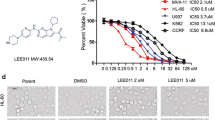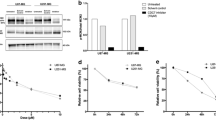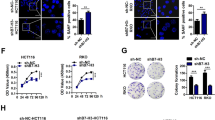Abstract
Cyclin-dependent kinases (CDKs) are highly conserved over evolutionary path and function as master regulators of the cell division cycle. Thus CDK inhibitors have been focused in the drug development for cancer and other cell proliferative disorders. Among these inhibitors Roscovitine is well known compound and under clinical trial currently while far less has been reported on another CDK inhibitor — BMI-1026, designed as a drug candidate also targeting the cell cycle. In this study we tried to define biological effects and possible mechanisms of the two chemicals by analyzing the altered transcriptome profiles when BMI-1026 and Roscovitine are applied on WI-38 cells. Our result revealed both BMI-1026 and Roscovitine produced similar gene expression profiles, where E2F target genes were suppressed in common, including cyclin A, MCM3 and PCNA along with activated p53 pathway. This finding strongly indicates that molecular machineries responsible for other established senescence models are also employed in the changes in WI-38 cells induced by the two CDK inhibitors.
Similar content being viewed by others
References
Morgan, D.O. Cyclin-dependent kinases: engines, clocks, and microprocessors. Annu. Rev. Cell Dev. Biol. 13, 261–291 (1997).
Malumbres, M. et al. Cyclin-dependent kinases: a family portrait. Nat. Cell Biol. 11, 1275–1276 (2009).
Sherr, C.J. Cancer cell cycles. Science 274, 1672–1677 (1996).
Fischer, P.M. & Gianella-Borradori, A. Recent progress in the discovery and development of cyclin-dependent kinase inhibitors. Expert Opin. Investig. Drugs 14, 457–477 (2005).
Shapiro, G.I. Cyclin-dependent kinase pathways as targets for cancer treatment. J. Clin. Oncol. 24, 1770–1782 (2006).
Collins, I. & Garrett, M.D. Targeting the cell division cycle in cancer: CDK and cell cycle checkpoint kinase inhibitors. Curr. Opin. Pharmacol. 5, 366–373 (2005).
Sausville, E.A. et al. Phase I trial of 72-h continuous infusion UCN-01 in patients with refractory neoplasms. J. Clin. Oncol. 19, 2319–2333 (2001).
Malumbres, M. & Barbacid, M. Cell cycle, CDKs and cancer: a changing paradigm. Nat. Rev. Cancer 9, 153–166 (2009).
Meijer, L. & Raymond, E. Roscovitine and other purines as kinase inhibitors. From starfish oocytes to clinical trials. Acc. Chem. Res. 36, 417–425 (2003).
Rossi, A.G. et al. Cyclin-dependent kinase inhibitors enhance the resolution of inflammation by promoting inflammatory cell apoptosis. Nature Medicine 12, 1056–1064 (2006).
Meijer, L. et al. Biochemical and cellular effects of roscovitine, a potent and selective inhibitor of the cyclin-dependent kinases cdc2, CDK2 and CDK5. Eur. J. Biochem. 243, 527–536 (1997).
Guzi, T. CYC-202 Cyclacel. Curr. Opin. Investig. Drugs 5, 1311–1318 (2004).
McClue, S.J. et al. In vitro and in vivo antitumor properties of the cyclin dependent kinase inhibitor CYC 202 (R-roscovitine). Int. J. Cancer 102, 463–468 (2002).
Aldoss, I.T., Tashi, T. & Ganti, A.K. Seliciclib in malignancies. Expert Opin. Investig. Drugs 18, 1957–1965 (2009).
Wesierska-Gadek, J. et al. Pleiotropic effects of selective CDK inhibitors on human normal and cancer cells. Biochem. Pharmacol. 76, 1503–1514 (2008).
Seong, Y.S. et al. Characterization of a novel cyclindependent kinase 1 inhibitor, BMI-1026. Cancer Res. 63, 7384–7391 (2003).
Seo, H.J. et al. BMI-1026 treatment can induce SAHF formation by activation of Erk1/2. BMB Rep. 41, 523–528 (2008).
Glickman, M.H. & Ciechanover, A. The ubiquitin-proteasome proteolytic pathway: destruction for the sake of construction. Physiol. Rev. 82, 373–428 (2002).
Campisi, J. Senescent cells, tumor suppression, and organismal aging: good citizens, bad neighbors. Cell 120, 513–522 (2005).
Herbig, U. & Sedivy, J.M. Regulation of growth arrest in senescence: telomere damage is not the end of the story. Mech. Ageing Dev. 127, 16–24 (2006).
Ben-Porath, L. & Weinberg, R.A. The signals and pathways activating cellular senescence. Int. J. Biochem. Cell Bio. 37, 961–976 (2005).
Narita, M. et al. Rb-mediated heterochromatin formation and silencing of E2F target genes during cellular senescence. Cell 113, 703–716 (2003).
Funayama, R. & Ishikawa, F. Cellular senescence and chromatin structure. Chromosoma 116, 431–440 (2007).
Sikora, E. et al. Impact of cellular senescence signature on ageing research. Ageing Res. Rev. 10, 146–152 (2011).
Webley, K. et al. Posttranslational modifications of p53 in replicative senescence overlapping but distinct from those induced by DNA damage. Mol. Cell. Biol. 20, 2803–2808 (2000).
d’Adda di Fagagna, F. et al. A DNA damage checkpoint response in telomere-initiated senescence. Nature 426, 194–198 (2003).
Yin, B. et al. Histone H2AX stabilizes broken DNA strands to suppress chromosome breaks and translocations during V(D)J recombination. J. Exp. Med. 206, 2625–2639 (2009).
Shiloh, Y. ATM and related protein kinases: safeguarding genome integrity. Nature Rev. Cancer 3, 155–168 (2003).
Kotala, V. et al. Potent induction of wild-type p53-dependent transcription in tumour cells by a synthetic inhibitor of cyclin-dependent kinases. Cell. Mol. Life Sci. 58, 1333–1339 (2001).
Author information
Authors and Affiliations
Corresponding authors
Rights and permissions
About this article
Cite this article
Lee, JH., Min, C., Kwak, SJ. et al. Genomewide transcription profiles altered by BMI-1026 and Roscovitine and its implication in cellular senescence. BioChip J 6, 362–371 (2012). https://doi.org/10.1007/s13206-012-6408-9
Received:
Accepted:
Published:
Issue Date:
DOI: https://doi.org/10.1007/s13206-012-6408-9




